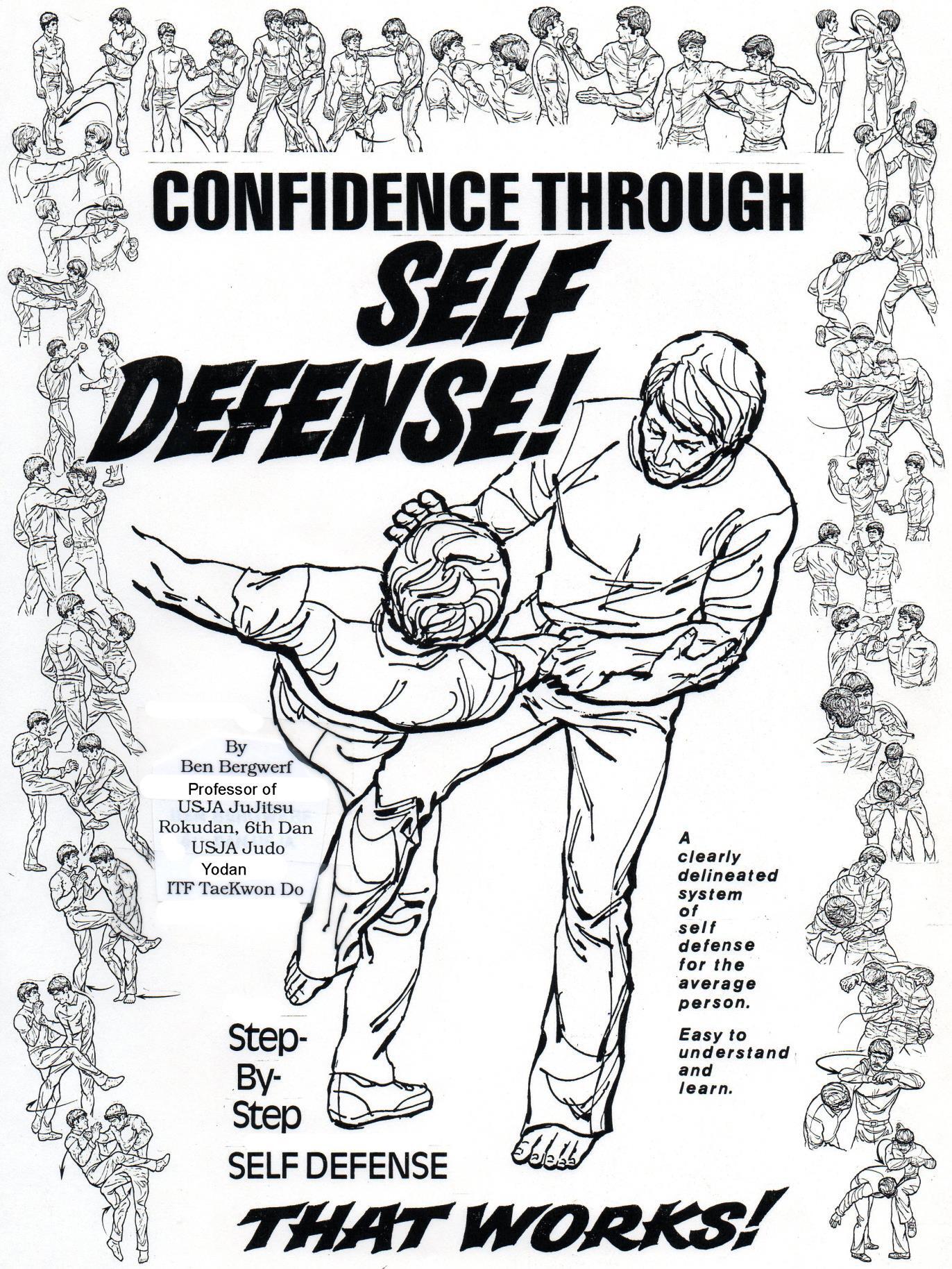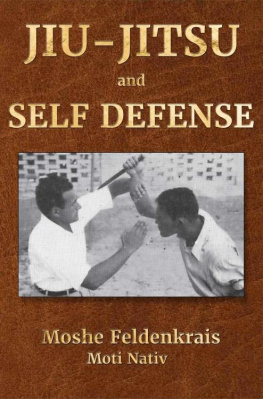
A
WARNING AND DISCLA MER
TABLE OF CONTENTS
CHAPTER 1 PAGE
Grabs .................................................................................................. 1
CHAPTER 2
CHAPTER 3
CHAPTER 4
CHAPTER 5
CHAPTER 6
CHAPTER 7
CHAPTER 8
C
SELF-DEFENSE
What's in it for you?
Have you ever been in a situation where you felt uncomfortable because an aggressive person was trying to bully you?
This self-defense course has been specifically designed to give men and women the means, knowledge and ability to face an attacker without fear. You will gain the confidence to ably defend yourself against just about any type of attack.
The book is based upon real life situations and conditions that we find in today's often violent environment. It will teach you the principles of self-defense by providing a number of specific means of escape from attacks, muggings, or other dangerous situations. It is based upon the author's 55 years of experience in the various martial arts along with practical experience in personal security work. It is not designed to develop specialized dexterity and agility, as would be required in the pure martial arts. Rather, it is based upon the natural abilities that people have and to combine these with the material taught in this course into a practical means of self-defense, building confidence and a sense of security.
The book is written in an easy to follow style and concentrates on those defenses that have been proven to work out on the street. The defenses can be learned by anyone and do not require any special skill or ability other than the desire to succeed.
D
About the Author:
Ben Bergwerf is a Rokudan (sixth degree black belt) in Judo and Kudan (ninth degree black belt) in jujutsu. For the past 60 years he has been practicing and teaching Judo, jujitsu, and self-defense methods. Born in The Netherlands, he emigrated to Wales and was national heavyweight champion of Wales, Great Britain for five years in a row, retiring an undefeated champion.
In the sixties Ben was a member of the Welsh National team in the Heavyweight Division competitions. Taught by European and Japanese champions, and recognized as an expert in the art, Ben is eminently qualified to bring a new dimension to the art of self- defense.
At age 18, when just a green belt in Judo, Ben captured the Open Judo championship in the over 400 member Jujutsu and Judo club in his native Holland, defeating even the Black Belt finalists. During his Army service as a Combat Judo instructor in the Artillery, he spent many hours perfecting his groundwork techniques to become one of the most respected grappling specialists, and later winning many of his matches on the ground.
He continued his Judo and Jujutsu career in Wales, Great Britain under the great Sensei Alan Petherbridge, Captain of the 1964 British Olympic Judo team to Japan and other greats such as Senta Yamada Shihan, Kaiwashi Shihan and Matshushita Shihan, to name but a few.
Ben used his training well. For several years he worked as a security specialist, body guard, and Chief of Security.
Presently, Professor Bergwerf teaches Combat Judo at The Citadel, a military college in Charleston, South Carolina, and keeps in touch with the latest developments in the martial arts, thereby improving his own style. He believes that training and learning never stops, and applies this credo to the martial arts, his teaching, and his professional career. To this end he also gained his Yodan rank in Korean TaeKwon Do.
Educated as a Mechanical Engineer, Ben has a Masters Degree in Business Management from Lake Forest Graduate School of Management and was the Director of Engineering in a Chicago, Illinois Hi-Tech R&D company.
E Ben was the key person to start the USJAs Jujutsu division in 1994, and was the Chairman of the Jujitsu Division and Chair of the rank board for over 10 years. In 2001, he was awarded 9 th degree black belt, Kudan, and was awarded Professor of Jujutsu rank in the USJA.
Sensei Bergwerf also published the recent Jujutsu manual on Amazon. A 560 page illustrated manual with over 600 photographs and their descriptions.
Acknowledgments:
This book would not have been possible without the help of a number of dedicated martial arts practitioners, my students, assistant instructors, or the very fine artist who drew the illustrations.
My thanks to Alan Petherbridge, the charismatic captain of the first British Judo team for the 1964 Tokyo Olympics, European Gold Medallist, and my first "Competitive Judo" Sensei. My competitive Judo coach and a tower of a man, whom I greatly admire.
To Anton Geesink, first non-Japanese World Champion, fellow Dutchman, and an inspiration to all who practice Judo/Jujutsu.
To the many Japanese Masters who traveled the world to "spread the Judo gospel," and who were and are my personal inspiration.
Special thanks to my TaeKwon Do teachers, Henry Szachowicz sixth degree, and Greggory Youstra eight degree, both specialists in their own art.
Drawing Credits:
Drawings lovingly done by Norman Helford, commercial artist, and one of my most dedicated students. He started in the art of jujitsu at the age of 64 and reached the rank of black belt at the age of 72, and a truly dedicated individual.
Thanks to all!!
Ben Bergwerf
Professor of Jujutsu, Kudan USJA F
INTRODUCTION
The key question in assessing any self-defense system is simple - does it work? After all is said and done that is what counts, and that question is what has guided me in writing this manual. After testing various self-defense systems for more than 50 years I have found that many are designed to look good in a show or demonstration but don't necessarily work in practice on the street.
As a 1st, 2nd, and 3rd degree black belt competitive judo participant I learned many throws and defenses, but, as a working security specialist in Europe, I learned that not everything I did in Judo competitions worked in real life situations. I found that, much to my dismay, someone causing trouble didn't always come up and hold his hands or body in just the right position so that I could throw or handle him. He might grab me by the throat or from the rear in a way that made things more difficult. It forced me to improvise.
The judo competitions provided a kind of classroom or laboratory for selfdefense while the job as security specialist tested the research. Those experiences and years of teaching self-defense have resulted in the system I describe in this manual.
I have adapted all the proven Jujutsu (or Jiu-Jitsu etc.) and Judo principles into self-defense techniques that have been effective in the classes I've taught. This system is based on the ancient Jujutsu which developed into the sport of Judo. Although Judo is the base, this system blends it with Karate, which is the empty hand fighting system from Japan, and Korean Karate, called Tae Kwon Do. You will also find elements of La Savate (French Foot fighting) and Combat Judo.
Do you need to know or understand all those mysterious Far Eastern fighting methods to master my system? Absolutely not. I have selected what I think are the best moves from those fighting methods and added other techniques that I know will work for the average person who needs some measure of self-defense and needs to learn it quickly. There are hundreds of throws, sweeps, and strangulations in Judo, but when you analyze the moves in a Judo contest, you realize that there may be only 10 to 15 movements that are basic and repeated over and over. The idea of this book is to teach you those basic movements and show you some ways to adapt them as you master the moves that work for you. The aim is to make self-defense as practical as possible. You don't have to be Hercules or have huge biceps to ward off an attacker. You can get out of trouble by applying the principles demonstrated here.

 A
A








